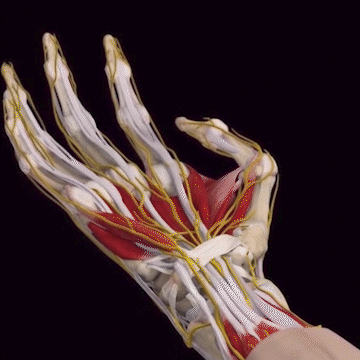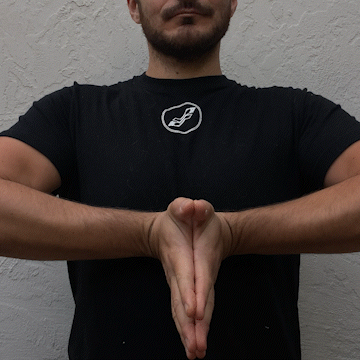Front Ensemble! Have you ever experienced sudden weakness or sharp shooting pain in your wrist & hand? If so, there's a chance you were experiencing a condition called Carpal Tunnel Syndrome (CTS). This condition is particularly common in the front ensemble because of the repetitive nature of the activity. This blog post will help you understand what it is, why it happens, how you can prevent it, and what to do if you develop it. Enjoy!
What is Carpal Tunnel Syndrome?
Carpal Tunnel Syndrome is a medical condition that results from the compression of the median nerve as it travels through the carpal tunnel in the wrist. This tunnel is a narrow passageway surrounded by bones and ligaments on the palm side of your hand. When the tunnel's size changes due to wrist movements or swelling, it can lead to nerve compression. Symptoms often include numbness, tingling, and weakness in the hand and arm.
The carpal bones and transverse carpal ligament create a tunnel for the flexor tendons and median nerve to pass through.
Carpal Tunnel Syndrome in Marimba Players
Marimba & Vibraphone players face a unique challenge. The weight of the mallets and the repetitive striking movements can increase the risk of developing CTS. This risk is compounded by the fact that they often practice for extended periods, which can lead to increased stress on the wrist and hand.
Table 1: Factors Contributing to CTS in Marimba Players
| |
| Constant striking of the marimba keys. |
| Holding and maneuvering the mallets puts strain on the wrist. |
| Extended periods of playing without adequate breaks. |
| Awkward wrist angles while playing. |
How Wrist Movements Affect the Carpal Tunnel
The size of the carpal tunnel is not static; it changes with wrist movements. When the wrist is bent in either direction, the space within the tunnel decreases, increasing the likelihood of compressing the median nerve. For marimba players, certain playing techniques and positions, such as wide spreads, may lead to more extreme wrist positions, further aggravating the risk.
Preventing CTS in Marimba Players
For marimba players, avoiding Carpal Tunnel Syndrome is crucial.
1. Tendon Glides
This movement helps glide the tendons through your carpal tunnel. A study from the Journal of Orthopedic & Sports Physical Therapy has shown that intermittent exercise of active wrist and finger motion for 1 minute can lower pressure in the carpal tunnel.
2. Median Nerve Glide
This movement glides the median nerve through the tunnel. When used in conjunction with tendon glides, it may reduce the symptoms of Carpal Tunnel Syndrome.
3. Wrist Flexor Stretch
Take 30 seconds after each exercise to stretch the wrist flexors. This can help reduce inflammation in the wrist from the repetitive exercise and minimize risk of developing CTS.
4. REST BREAKS!
One of the best ways to prevent Carpal Tunnel Syndrome is to incorporate frequent rest breaks into practice. We often get caught up in the reps trying to clean clean clean that we forget our hands are working very hard! Frequency and duration of rest breaks will vary depending on the intensity of the work you're doing. High intensity chunks should include a 1 minute rest break every 6-12 reps.
What if you've already got Carpal Tunnel Syndrome?
1. Seek professional medical attention
If you're already showing signs of CTS, it's best to get a professional medical diagnosis and treatment EARLY. Your doctor or physical therapist will prescribe you with stretches and exercises to help rehabilitate your wrist so you can get back out on the field.
2. Wear a Wrist Splint
Splinting the wrist in a neutral position while sleeping or doing errands can help relieve pressure in the carpal tunnel and may reduce symptoms. This is not something I recommend wearing at all times. This should be used periodically and followed with gentle wrist and hand movements to prevent wrist stiffness from developing.
If needed, this wrist splint will help secure the wrist in a neutral position.
3. Anti-Inflammatory medication (NSAIDS)
Over-the-counter non-steroidal anti-inflammatory drugs like ibuprofen or naproxen are commonly used to reduce inflammation and swelling in the carpal tunnel, which can alleviate pressure on the median nerve and thus reduce symptoms like pain and numbness.
However, it's important to note that while these medications can provide temporary relief, they don't treat the underlying cause of CTS. Long-term management of CTS often involves a combination of approaches, including physical therapy, ergonomic adjustments, and in some cases, surgical intervention. Also, it's always advisable to consult with a healthcare professional before starting any medication, especially for ongoing conditions like CTS, to ensure it's safe and appropriate for your specific health needs.
FAQs About Carpal Tunnel Syndrome and Marimba Playing
Can playing the marimba cause Carpal Tunnel Syndrome?
Yes, the repetitive movements and wrist strain can contribute to developing CTS.
What are early signs of CTS in marimba players?
Early signs include tingling, numbness, and pain in the fingers or hand.
Are there any preventive measures for CTS in musicians?
Regular breaks, wrist exercises, and proper technique can help prevent CTS.
Is it possible to continue playing marimba with CTS?
Yes, but it may require technique adjustments and medical guidance.
Early stages of CTS can often be managed with treatment, but severe cases might require surgery.
In conclusion, while Carpal Tunnel Syndrome poses a significant risk for marimba players in , understanding the condition, its causes, and preventive measures can help mitigate this risk. It's essential for musicians to pay attention to their body's signals and seek professional advice when necessary. Remember, maintaining hand and wrist health is crucial for a long and fruitful musical career.
Thanks for reading, ForteFam!







_edited.png)



















